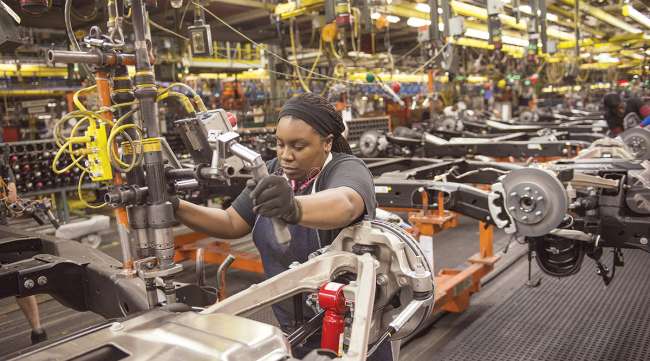Staff Reporter
Manufacturing Sector Improves Despite Persisting COVID Issues

[Ensure you have all the info you need in these unprecedented times. Subscribe now.]
Manufacturing has improved greatly since the onset of the coronavirus pandemic, but a lot of work remains, experts said during a panel discussion Nov. 19.
The virtual event was part of the 2020 NAFC Annual Conference, which brings together experts from various sectors to discuss trends and challenges in trucking. The National Accounting & Finance Council is a division of American Trucking Associations.
The National Association of Manufacturers, in its quarterly industry survey released Sept. 10, found that 66% of manufacturers were positive about their outlook. That is up from 33.9% in May.

Moutray
“Overall, the manufacturing sector has obviously been pretty hard hit during the COVID-19 crisis,” NAM Chief Economist Chad Moutray said.
“2019 was really dominated by the trade war and slow global growth,” he added. “You got the sense as we were coming into 2020, things were starting to pick up a little bit. The risk of a recession, believe it or not, was actually starting to wane and things were stabilizing around the world. We saw a little bit of improvement in January and February until COVID-19 hit.”
Moutray noted respondents were asked in the survey when they expect to return to pre-pandemic levels.

“A quarter of our members said they were already back or are expecting to get back in the third quarter,” he said. “But we still have roughly 62% of our members who have said they won’t get back to pre-pandemic levels until at least next year if not 2022 or later than that. My personal view is we won’t get back to pre-pandemic levels until the second half of next year.”
NAM is conducting an updated version of the survey, and the results are expected by early December. Moutray noted those taking the survey were asked the same question about when they expect to be back to normal.
“In terms of the overall challenges, we are obviously in a recession,” he said. “The No. 1 issue over the last two quarters was a weaker domestic economy. But it’s really closely followed, and this is a bit of a paradox here, by attracting and retaining a quality workforce.
“We have an unemployment rate that is double what it was in February. We lost around 600,000 workers to date relative to where we were in February.”
Moutray said he continues to hear about challenges from manufacturers on labor issues, such as there being a skills mismatch. But he also noted manufacturing is trending in the right direction, even if production numbers show there is a long way to go.
“Manufacturing production is still 4.8% below where it was in February,” Moutray said. “But there is still progress there, especially when you consider manufacturing production fell between February and April by roughly 20%.
“The fact that we are down only 4.8% really speaks to how impressive the gains over the last few months have been, and yet there is some more to be done there.”
He said automobile manufacturing took a major hit at the start of the pandemic but has since started climbing back. It isn’t where it was, but it’s the closest to a V-shape recovery out of all the manufacturing sectors.
Most manufacturing subsets are improving overall, Moutray said, and he believes this shows manufacturing might rebound out of the recession sooner than expected.

Sanchez
Emily Sanchez, director of economics and data analytics at the American Chemistry Council, stressed trucking’s importance to that sector.
“Chemical manufacturing is something that is occurring all over the United States,” she said. “We have facilities in every state, and we have industry activity in every state, and the industry employs over a half-million people across the country. So we depend heavily on truck services to move our products. In fact, trucking is our primary transportation mode.”
Sanchez added that the chemical manufacturing sector was seeing major investments before the pandemic hit. She noted the transportation sector should expect high demand from chemical manufacturing once the crisis abates.
“COVID and the recession have put a pause on many businesses, and chemicals have not been an exception,” Sanchez said. “But longer term, the favorable underlining dynamics remain. It is not realistic to expect additional projects and capacity to come on right now, so we pushed back some of our plans for industry expansion for another year or so.”
Want more news? Listen to today's daily briefing:
Subscribe: Apple Podcasts | Spotify | Amazon Alexa | Google Assistant | More




